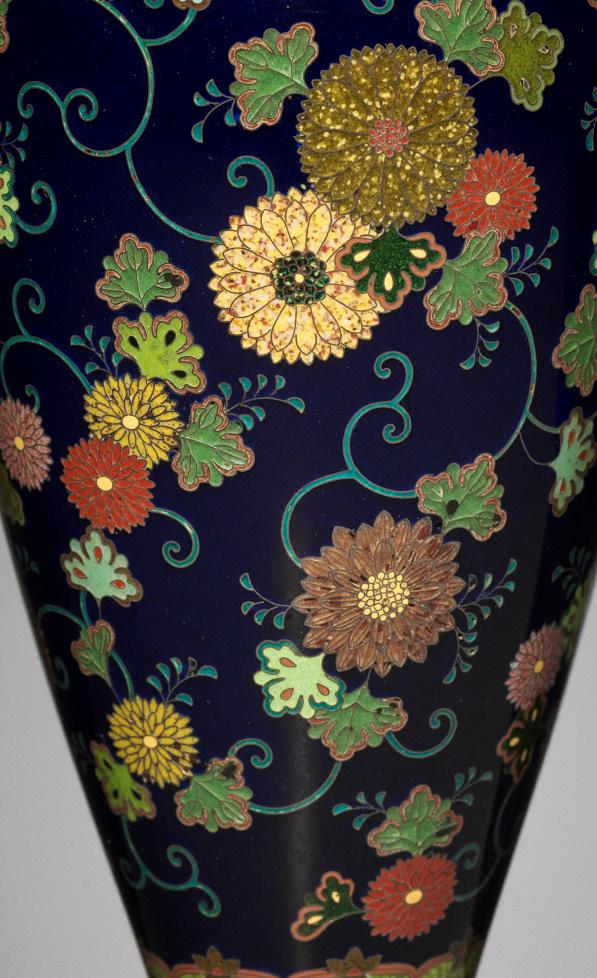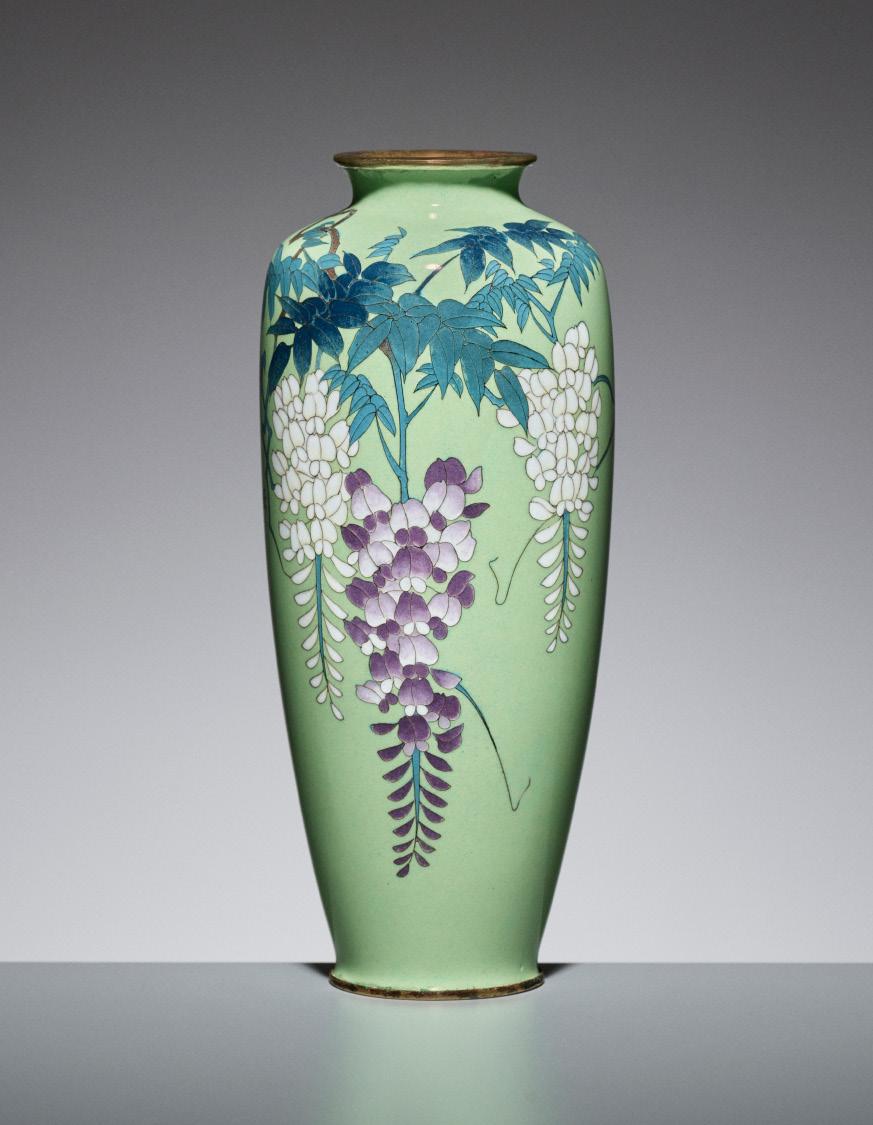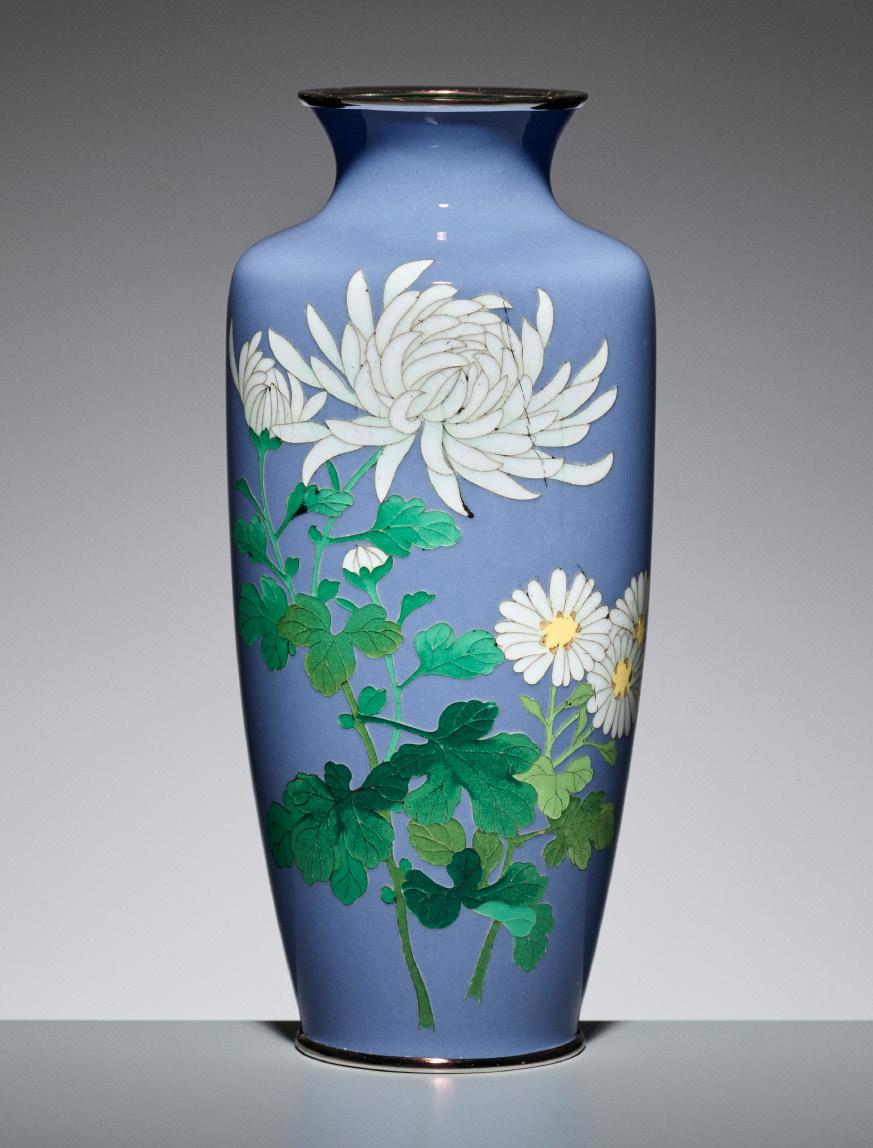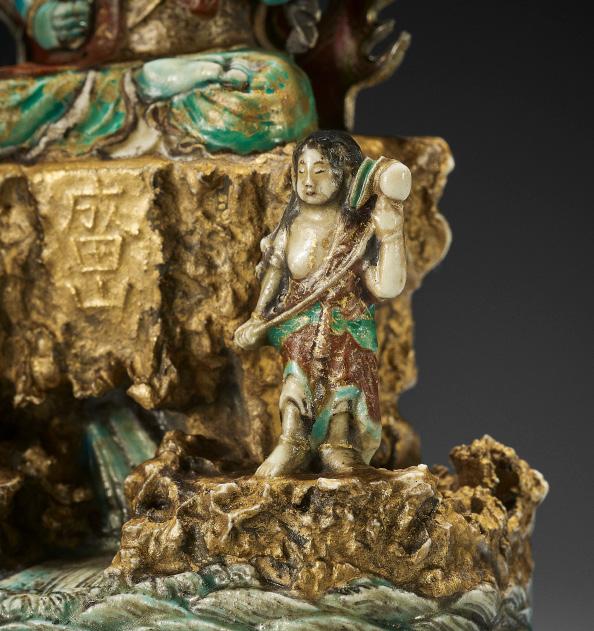
24 minute read
Cloisonné, Ceramic & Porcelain
Lots 64 to 92




64 | NAMIKAWA YASUYUKI:
A FINE CLOISONNÉ ENAMEL VASE
By Namikawa Yasuyuki (1845-1927), signed Kyoto Namikawa Japan, circa 1890, Meiji period (1868-1912)

The silver-mounted baluster-shaped vase with an elongated neck and a flaring lip, masterfully worked with polychrome enamels and silver wire depicting varieties of kiku (chrysanthemum) blossoms and scrolling vines, all against a midnight blue ground, the shoulder decorated with a band of butterflies and flower heads, and the neck with formal lozenge motifs on a mustard-yellow ground. The foot ringed with panels of flower heads on a lime-green ground. Signed underneath on a raised signature tablet KYOTO NAMIKAWA.
HEIGHT 13.3 cm WEIGHT 175 g
Condition: Pristine condition with only minimal wear. Minor nicks and traces of use to silver fittings. Tiny area of enamel thinning original to manufacture. Provenance: US private collection.
Namikawa Yasuyuki (1845-1927) is widely regarded as one of the greatest cloisonné makers of all time. He won prizes at the Philadelphia World Fair of 1876, then at the Paris World Fair of 1878, and later at the 1889 Paris Fair. He was also honored at the series of National Industrial Expositions which was instituted in 1877. He won altogether 31 prizes at expositions both at home and abroad. In 1896 together with the unrelated Namikawa Sosuke, Yasuyuki was appointed as a Teishitsu Gigeiin, or ‘Imperial Artist’, the only two cloisonné makers to be so honored.
Literature comparison:
For a bottle of nearly identical design, see Impey and Fairley, eds., Enamel, vol. II of Meiji no Takara, Treasures of Imperial Japan (London: Kibo Foundation, 1995), pl. 8. Namikawa Yasuyuki (1845-1927)
AUCTION COMPARISON:
Compare to an almost identical vase sold at Christie’s, Japanese and Korean Art, 22 September 2005, New York, lot 256 (sold for 28,800 USD).
Estimate EUR 25,000
Starting price EUR 12,500


65 | NAMIKAWA YASUYUKI:
A SUPERB AND VERY RARE MINIATURE CLOISONNÉ ENAMEL BOX AND COVER
Attributed to Namikawa Yasuyuki, unsigned Japan, late 19th century, Meiji period (1868-1912)
The silver-mounted octagonal box with a faceted cover, masterfully worked with polychrome enamels and silver wire, depicting various stylized floral diapered patterns arranged in neatly enameled panels of alternating color. The lid with a central octagonal reserve depicting a majestic phoenix showing all the various colored enamels used throughout the design of the box, against a bright yellow ground.
SIZE 4 x 3.8 x 3.5 cm WEIGHT 91 g
Condition: Very good condition with minor old wear. The box: Perfect condition. The lid: Minuscule hairlines to the edge of two panels. One panel with two microscopic, restored areas, all of which is only noticeable under strong UV-light and magnification. [Please request additional images made under UV-light from us] Provenance: US private collection.
The box and cover are designed in a clever way so that the lid can only be fitted on the box when the panels of the same color are matched. Namikawa Yasuyuki (1845-1927) is widely regarded as one of the greatest cloisonné makers of all time. He won prizes at the Philadelphia World Fair of 1876, then at the Paris World Fair of 1878, and later at the 1889 Paris Fair. He was also honored at the series of National Industrial Expositions which was instituted in 1877. He won altogether 31 prizes at expositions both at home and abroad. In 1896 together with the unrelated Namikawa Sosuke, Yasuyuki was appointed as a Teishitsu Gigeiin, or ‘Imperial Artist’, the only two cloisonné makers to be so honored.
AUCTION COMPARISON
Compare to a very similar miniature box and cover by Namikawa Yasuyuki, yet arguably considerably less fine than the present example, sold at Christie’s, Japanese and Korean Art, 18 September 2013, New York, lot 776 (sold for 21,250 USD). Namikawa Yasuyuki (1845-1927)
Estimate EUR 15,000 Starting price EUR 7,500


66 | A MIDNIGHT
Japan, Meiji period (1868-1912)
The rounded square baluster body rising from a short spreading foot to a slender waisted neck with everted rim, decorated in bright enamels with a blossoming cherry tree as well as peonies, chrysanthemums, and various other flowers, the reverse with iris and grass blades, a key-fret band below the rim and a lappet band above the foot, all reserved against the midnight blue ground.
HEIGHT 18.2 cm WEIGHT 214.6 g
Condition: Very good condition with minor wear and manufacturing irregularities, expected minor pitting, and occasional light scratches. Provenance: Viennese private collection, acquired in the local trade before 2000.
Estimate EUR 1,200 Starting price EUR 600

67 | A MIDNIGHT
Japan, Meiji period (1868-1912)
The baluster body rising from a short foot to a broad shoulder with a slender waisted neck and everted rim, one side decorated in polychrome enamels with a sparrow in flight surrounded by chrysanthemums with stylized scrolling petals and other flowers with stems, leaves, and buds, the neck and foot with geometric borders.
HEIGHT 12.5 cm WEIGHT 221.9 g
Condition: Good condition with minor wear and manufacturing irregularities, expected pitting, occasional light scratches and few minuscule losses. Provenance: Viennese private collection, acquired in the local trade before 2000.
Estimate EUR 1,000 Starting price EUR 500


68 | A PAIR OF SMALL CLOISONNÉ VASES
Japan, Meiji period (1868-1912)
Both vases have ovoid shapes and everted lips. The floral composition on a deep black-blue background is rather free and very lively in a decorative way, showing tangled branches of the plum tree (ume) but also other blossoms and leaves, including lotus.
HEIGHT 14.7 cm WEIGHT 522 g
Condition: Good condition, the first with two tiny nicks, the second with a crack. Provenance: From an Austrian private collection, formerly collection Doblhoff.
Estimate EUR 2,000
Starting price EUR 1,000

69 | AN UNUSUAL GINBARI
CLOISONNÉ ENAMEL INKWELL AND COVER WITH IRIS AND BUTTERFLIES
Japan, Meiji period (1868-1912)
The inkwell supported on four lobed feet, the hinged cover of domed square form, decorated in bright ginbari enamels with iris flowers and butterflies, reserved against a pale green ginbari ground.
HEIGHT 4.5 cm, WIDTH 7.8 cm WEIGHT 128.6 g
Condition: Good condition with minor wear and manufacturing irregularities, expected pitting, few small nicks and hairline cracks, and occasional light scratches. Provenance: Viennese private collection, acquired in the local trade before 2000.
Estimate EUR 800
Starting price EUR 400


71 | A PAIR OF MIDNIGHT BLUE CLOISONNÉ ENAMEL VASES WITH PHOENIXES
Japan, Meiji period (1868-1912)
The slender bulbous body rising from a spreading foot to a short waisted neck with everted rim, the upper area of the body with colorful ginbari depicting a phoenix, the foot with a band of small circles.
HEIGHT 21.1 cm and 21.2 cm WEIGHT 321.6 g and 324.9 g
Condition: Very good condition with minor wear and manufacturing irregularities, such as minor pitting. Provenance: Canadian private collection, old labels to bases.
70 | A MIDNIGHT BLUE
CLOISONNÉ ENAMEL VASE WITH A DRAGON
Japan, Meiji period (1868-1912)
The baluster body rising from a short foot to a broad shoulder with a slender waisted neck and everted rim, one side decorated in bright ginbari enamels with a fierce and sinuously coiled dragon surrounded by flames.
HEIGHT 15.5 cm WEIGHT 219.3 g
Condition: Good condition with minor wear, expected pitting, occasional light scratches, and few minuscule nicks. Provenance: Viennese private collection, acquired in the local trade before 2000.
Estimate EUR 800
Starting price EUR 400
Estimate EUR 1,500
Starting price EUR 750


72 | A SMALL MIDNIGHT
BLUE CLOISONNÉ ENAMEL VASE WITH WISTERIA
Japan, Meiji period (1868-1912)
The bulbous body rising from a short spreading foot to a waisted neck with everted rim, one side decorated in pale and dark green and white enamels with wisteria flowers hanging from a branch with leaves and vines reserved against the midnight blue ground.
HEIGHT 6.1 cm WEIGHT 65.5 g
Condition: Very good condition with minor wear and manufacturing irregularities, expected pitting, and few minuscule losses. Provenance: Viennese private collection, acquired in the local trade before 2000.
Estimate EUR 600
Starting price EUR 300
73 | AN UNUSUAL IRON-
Japan, Meiji period (1868-1912)
The ovoid body rising from a short spreading foot and short waisted neck with everted rim, decorated with bright enamels depicting peonies and chrysanthemums with leaves and buds, all reserved against the iron-red ground.
HEIGHT 11.8 cm WEIGHT 148.5 g
Condition: Very good condition with minor wear and manufacturing irregularities, expected pitting, a few minuscule losses and occasional light scratches. Provenance: Viennese private collection, acquired in the local trade before 2000.

Estimate EUR 1,000 Starting price EUR 500
74 | A LIME GREEN
CLOISONNÉ ENAMEL VASE WITH WISTERIA
Japan, Meiji period (1868-1912)
The slender baluster body rising from a short spreading foot to a short waisted neck with everted rim, one side decorated in bright enamels with wisteria hanging from a gnarled branch with leaves, reserved against the lime green ground.
HEIGHT 15.5 cm WEIGHT 157.8 g
Condition: Excellent condition with minor wear and manufacturing irregularities, expected minor pitting. Provenance: Viennese private collection, acquired in the local trade before 2000.
Estimate EUR 1,000 Starting price EUR 500

75 | ANDO: AN
By the Ando company, signed with the mark of the Ando company Japan, Meiji period (1868-1912)
The baluster body rising from a short spreading foot to a broad shoulder with waisted neck and everted rim, one side decorated in polychrome enamels with peonies and chrysanthemums with flowers, leaves, and one bud, reserved against a pale grayish-blue ground, the recessed base with the Ando company mark against a deep green ground.
HEIGHT 18.3 cm WEIGHT 335.4 g
Condition: Good condition with minor wear and manufacturing irregularities, expected pitting, a few hairlines and minor scratches. Provenance: Viennese private collection, acquired in the local trade before 2000.

Estimate EUR 1,200 Starting price EUR 600
76 | AN EMERALD GREEN CLOISONNÉ
ENAMEL VASE WITH PEONY, ATTRIBUTED TO THE WORKSHOP OF ANDO JUBEI
Attributed to the workshop of Ando Jubei, unsigned Japan, Showa period (1926-1989), mid-20th century
The baluster body rising from a spreading foot to a broad shoulder with a short waisted neck and everted rim, one side decorated in bright enamels with blossoming and budding peonies growing from long stems with veined leaves.
HEIGHT 24.7 cm WEIGHT 1,730 g
Condition: Excellent condition with minor wear and manufacturing irregularities, expected minuscule pitting. Provenance: Viennese private collection, acquired in the local trade before 2000.
Estimate EUR 1,500 Starting price EUR 750

77 | ANDO: A DEEP PURPLE
CLOISONNÉ ENAMEL VASE WITH ASTER
By the Ando company, signed with the mark of the Ando company Japan, Showa period (1926-1989), mid-20th century
The slender baluster body rising to a broad waisted neck and everted rim, one side decorated in enamels of white and shades of purple with aster flowers on thin stems with leaves and buds, reserved against the deep purple ground, the recessed base with the Ando company mark.
HEIGHT 30.3 cm WEIGHT 706.4 g
Condition: Good condition with minor wear and manufacturing irregularities, expected pitting, light scratches, and manufacturinginherent hairlines. Provenance: Viennese private collection, acquired in the local trade before 2000.
Estimate EUR 1,500 Starting price EUR 750

78 | ANDO: A PALE GREEN CLOISONNÉ ENAMEL VASE WITH ORCHIDS
By the Ando company, signed with the mark of the Ando company Japan, Showa period (1926-1989), mid-20th century
The baluster body rising from a spreading foot to a broad shoulder with a short waisted neck and everted rim, one side decorated in bright enamels with two flowering orchids, the foot rim impressed with the mark of the Ando company.
HEIGHT 24.7 cm WEIGHT 1,426 g
Condition: Excellent condition with minor wear and manufacturing irregularities, expected minuscule pitting. Provenance: Viennese private collection, acquired in the local trade before 2000.
Estimate EUR 1,500 Starting price EUR 750


79 | A FINE KORANSHA PORCELAIN VASE WITH TWO KIRIN
By the Koransha company Japan, c. 1900, Meiji period (1868-1912)
The bulbous body rising from a spreading foot to a waisted neck with a gilt everted rim, the sides finely painted in underglaze blue with two fierce kirin amid reishi-shaped clouds, with flames enameled in iron-red and heightened with gilt, the clouds heightened with gilt as well, small sections of clouds with gilt and enameled in white, the foot and neck each with a circumferential double circle, the base with the orchid mark of Koransha.
HEIGHT 24.9 cm
Condition: Excellent condition with only minor wear and firing irregularities. Provenance: UK private estate.
Fukagawa is the family name of the founder and owner of the Koransha company. The combination of the orchid mark of Koransha and signature Fukagawa sei/zo appears to have been used until the company was split in 1889, after which the orchid marks started to appear alone in wares of the Koransha company, such as in the present vase.
Estimate EUR 2,000
Starting price EUR 1,000

By the Koransha company, signed with the orchid mark of the Fukugawa Koransha company Japan, early 20th century, Meiji (1868-1912) to Taisho period (1912-1926)
The globular jardinière rising from a ring foot to a rounded shoulder with incurved rim, finely painted underglaze cobalt blue and in bright enamels with gilt accents depicting carps swimming in a pond, two on one side and a single carp on the other, under autumn leaves, some falling into the water, the interior with clusters of reishi-shaped leaves, the mouth with a lobed leaf border, the foot with two circumferential lines, the recessed base with the orchid mark of the Fukugawa Koransha company.
HEIGHT 20 cm, DIAMETER 30 cm
Condition: Very good condition with minor wear and firing irregularities, such as a firing crack to the interior of the foot, and dark spots, some wear to gilt. Provenance: German private collection.
AUCTION COMPARISON
Compare a closely related jardinière by the Fukugawa Koransha company at Bonhams, Fine Japanese and Korean Art, 20 March 2019, New York, lot 322 (sold for 1,785 USD).
Estimate EUR 1,500 Starting price EUR 750
81 | MOMOTA:
A MULTILOBED ENAMELED PORCELAIN TRAY
By Momota, signed Momota zo kore Japan, late 19th to early 20th century, Meiji (1868-1912) to Taisho period (1912-1926)
The circular tray molded with a lobed rim enameled in black and gold with a geometric border, the interior finely enameled in black, brown, gray, white, green, and turquoise with a small temple complex nestled between pine trees and a pagoda, several small huts lining the other shore, with some sailing boats, many birds flying in the underglaze gray mist, and Mount Fuji towering in the background, all within a molded circular bead frame, the underside inscribed Dai-Nihon Yokohama ko (‘Yokohama Port, Great Japan’) and signed MOMOTA zo kore (‘this is made by’).
DIAMETER 38.5 cm
Condition: Excellent condition with minor wear and firing flaws, including glaze recesses and few open bubbles, particularly visible to the underside and two of the molded beads, and some wear to the enamels. Provenance: German private collection.

Estimate EUR 1,500 Starting price EUR 750

82 | KINKOZAN: A FINE SATSUMA EARTHENWARE DISH WITH A DANCER AND MUSICIANS
By Kinkozan, signed Nihon Kyoto Kinkozan zo Japan, Kyoto, Meiji period (1868-1912)
The rounded sides rising from a short ring foot to the gilt rim, the interior finely decorated with bright enamels and gilt, partly in relief, depicting a bijin dancing, holding an uchiwa (fan) in one hand and wearing a beautiful patterned robe, accompanied by two men seated behind her, one playing the biwa and the other reciting a poem, in front of a large tsuitate (standing screen) painted with crashing waves and the setting sun, all framed by a band of wave or diaper-patterned reishi heads and geometric-floral designs, the underside signed in gilt Nihon Kyoto Kinkozan zo [Made by Kinkozan, Kyoto, Japan] DIAMETER 37.4 cm
Condition: Very good condition with minor wear and firing flaws, such as thin glaze lines, small firing cracks, and few open bubbles, some wear to gilt and enamels. Provenance: French private collection.
AUCTION COMPARISON
For a related vase with the same signature, see Christie’s, Japanese and Korean Art, 18 September 2013, New York, lot 786 (sold for 3,750 USD).
Estimate EUR 3,000
Starting price EUR 1,500

83 | KINKOZAN: A SATSUMA CERAMIC DISH
WITH SCROLL PAINTINGS OF POETS
By Kinkozan, signed Kinkozan with impressed seal Japan, Kyoto, Meiji period (1868-1912)
Of circular form with a low ring foot and decorated in polychrome enamels and gilt with three ‘hanging scroll’ reserves depicting female poets, the left panel showing the poet with two children in a winter landscape, the central panel showing her next to a blossoming cherry tree, and the right panel showing the poet at a scholar’s desk with an open book in front of her and a folding screen in the background, looking out towards the rocky landscape. Below the scroll painting is a low table with a basket of chrysanthemums and Buddha’s hand citrus on leafy twigs. All on a midnight blue ground, elaborately and densely decorated in gilt with phoenixes, clouds, nashiji, and circular designs, the interior rim decorated in gilt with scrolling vines and stylized chrysanthemums, the whole exterior with scattered gilt flowers, the recessed base glazed white. Signed KINKOZAN with an impressed seal to the base.
DIAMETER 31.5 cm
Condition: Good condition with traces of wear, some minor wear to the glaze, and firing irregularities. Provenance: British collection.
AUCTION COMPARISON
For a considerably smaller Kinkozan dish with ‘hanging scroll’ reserves by Sozan for the Kinkozan workshop, see Bonhams, Fine Japanese and Korean Art, 15 March 2017, New York, lot 6271 (sold for 31,250 USD).

Estimate EUR 5,000
Starting price EUR 2,500

84 | KINKOZAN: A LARGE PAIR OF SATSUMA EARTHENWARE CONICAL VASES
By Kinkozan, signed Kinkozan zo Japan, Kyoto, Meiji period (1868-1912)
The vases each of conical form with recessed base and small mouth, the body finely painted en grisaille with gilt accents depicting grapevines bearing fruit and leaves as well as a bee in flight, the other side with a gently curving panel decorated in gilt and polychrome enamels with diapered patterns with floral and geometric designs, each signed KINKOZAN zo to the lower body.
HEIGHT 28.7 and 29.2 cm
Condition: Overall very good condition with minor wear, the vases each with a small hairline to the rim and neck, one only visible to the interior, one vase with a tiny chip to the foot, minor wear to gilt. Provenance: Old Swiss private collection formed in the 1940s/50s.
AUCTION COMPARISON
Compare a related but smaller conical vase by Kinkozan, but with a wider mouth and less elaborate decoration, at Bonhams, Fine Japanese Art, 5 November 2009, London, lot 207 (sold for 4,320 GBP). Compare also another related but smaller conical vase by Kinkozan, but reticulated, at Bonhams, Fine Japanese Art, 11 November 2010, London, lot 264 (sold for 16,800 GBP).
Estimate EUR 4,000
Starting price EUR 2,000


85 | KINKOZAN: A RARE AND FINE
SATSUMA JAR AND COVER
By Kinkozan, signed Kinkozan zo Japan, Kyoto, late 19th century, Meiji period (1868-1912)

Shaped as a bell, the blue ground neatly enameled in gray with a meticulous floral pattern, appearing like fine incision work, and with two gilt fan-shaped reserves, one containing a bijin seated on a bench in a garden with a blossoming tree in the background and the other with a samurai scene, both painted in bright enamels with gilt highlights, the small cover with similar silver decorations on a blue ground and a small blue spherical finial with fine gilding, the underside with a gilt floral décor and the signature KINKOZAN zo.
HEIGHT 8.8 cm
Condition: Very good condition with minor surface wear, some minor wear to gilt as well. Provenance: Old Austrian private collection, acquired before 1930.
Estimate EUR 1,000 Starting price EUR 500
86 | KOZAN: A FINE SATSUMA EARTHENWARE
BOWL WITH SAMURAI SCENE
By Kozan, signed Kozan Japan, late 19th century, Meiji period (1868-1912)
The rounded sides rising from a short foot ring to a straight gilt rim, finely decorated in bright enamels and gilt, to the interior with a scene of many samurai in a court setting as well as a broad and varied floral band framed by two dense geometric bands, and to the exterior with a band of longevity peaches and peonies above various scholar’s objects divided by geometric bands, the recessed base with the gilt signature KOZAN within a gilt double square.
DIAMETER 15.4 cm
Condition: Excellent condition with minor wear and firing irregularities. Provenance: French private collection.
AUCTION COMPARISON
Compare a similar bowl by the same maker, of slightly smaller size, at Bonhams, Fine Japanese Works of Art, 20 March 2012, New York, lot 2228 (sold for 4,000 USD).
Estimate EUR 1,500 Starting price EUR 750


87 | A FINE SATSUMA CERAMIC KOGO
ATTRIBUTED TO CHIN JUKAN XII
Attributed to Chin Jukan XII (1835-1906), unsigned Japan, second half of 19th century
The two-part kogo (incense box) finely modelled as a young boy with a large bag inscribed with the characters dai (great) and matsu (pine), holding a sweet potato in his hand. Beautifully decorated with polychrome enamels of red, blue, black, and gold. LENGTH 8 cm
Condition: Very good condition, one tiny chip to the edge of the sweet potato Provenance: Collection of Louis Lawrence, author of Hirado: Prince of Porcelains (Chicago 1997, part of the Encyclopedia of Japanese Art Series).
Sweet potatoes are often referred to as “Satsuma Imo” in Japan as the province is traditionally the center of production. There are many stories of boys raiding the fields to pick these sweet delights to eat them. The representation of this kogo is very unusual.
Chin Jukan XII (1835-1906) was a highly skilled potter and an innovative entrepreneur. His work was first displayed to the West at the 1867 exposition in Paris where it was internationally acclaimed. The resulting success was the catalyst that inspired the Japanese export trade to blossom with overglaze decorated ceramics that became known as Satsuma ware being created in many regions of the country. Few potters or decorators were able to achieve the quality of workmanship attained by Chin Jukan XII. Interestingly the renowned Osaka based decorator, Yabu Meizan, ordered all his blanks from Chin Jukan rather than create them himself.
LITERATURE COMPARISON
A very similar model is in the collection of the British Museum, accession no. Franks.2052.

Estimate EUR 1,000 Starting price EUR 500
88 | A LARGE ENAMELED
KUTANI PORCELAIN CHARGER WITH FALCON AND CRANES
Signed Kutani sei Japan, Meiji period (1868-1912)
The interior finely painted in gilt and bright enamels with three cranes standing on the shore next to a gnarled tree and large blossoming flowers, a falcon flying above with a fourth crane trapped in its talons, several fishermen in boats toward the center in front of a small village with huts and blossoming trees, two mountains and clouds in the background. With a metal mounting for suspension to a wall.
DIAMETER 46.2 cm
Condition: Very good condition with minor wear and firing irregularities, such as kiln grit to the base and some dark spots, occasional light scratches, and some wear to enamels. Provenance: German private collection.

Estimate EUR 1,500 Starting price EUR 750

89 | A RARE KUTANI STANDING SCREEN WITH KANZAN AND JITTOKU
Japan, Meiji period (1868-1912)
Molded as a standing screen with a central depiction of Kanzan and Jittoku, the latter seated and holding a broom, the former standing and holding a scroll, on a craggy rock, surrounded by gilt chidori (plovers) in flight and gilt and blue crashing waves over a white stippled ground. The green outer border of the screen is decorated with gilt phoenixes, scrolling tendrils and leaves, the black screen stand with scrolling tendrils and flowers in gold, the top of the screen with a finely molded cord with lotus tassels at the bottom.
SIZE 24.5 x 21 cm
Condition: Excellent condition with only few minor traces of wear, such as very minute flakes to the rear of the feet and a small burst bubble to one of the waves. Provenance: French private collection.
Estimate EUR 2,500
Starting price EUR 1,250

90 | A SATSUMA STYLE CERAMIC FIGURE
OF FUDO MYO-O AND ACOLYTES
Japan, late 19th to early 20th century, Meiji period (1868-1912)
The blue Fudo Myo-o (Acala) is depicted seated on a rockwork base with a short inscription, ‘Naritasan‘, and towering over crashing waves, holding a metal sword hilt in his right hand, the left hand raised, wearing a robe draped over his left shoulder and richly adorned in beaded jewelry, a flaming mandorla crafted from metal attached behind him, flanked by two of his acolytes below, Seitaka to his left and Kongara to his right, each standing on a similar rockwork base, all supported on a stepped plinth, the back with an impressed double-gourd seal mark.
HEIGHT 12.7 cm
Condition: Overall good condition, extensive wear, minor losses to the attributes, chips to the lotus held by Kongara, one hand of Seitaka is missing, further minuscule losses here and there. Provenance: German private collection in the Rhineland. Naritasan (“Narita mountain”) Shinshoji (“New victory temple”) is a Shingon Buddhist temple located in central Narita, Chiba prefecture. It was founded in 940 by Kancho Daisojo, a disciple of Kobo Daishi. It is dedicated to Fudo Myo-o and is one of the bestknown temples in the Kanto region.
Estimate EUR 1,500
Starting price EUR 750 The Great Peace Pagoda (Daito), added in 1984


Fudo Myo-o in the Great Peace Pagoda



91 | A BIZEN STONEWARE MODEL OF A SNARLING SHISHI
Japan, 19th century, Edo period (1615-1868)
The shishi in a recumbent posture, with curled flaming mane and tail, the mouth wide open revealing tongue and fangs as it lets out a fierce snarl, the eyes pierced.
WIDTH 22 cm Condition: Excellent condition with only minor wear. Provenance: From the private collection of Professor Filippo Salviati, Rome, Italy. A professor of archeology and art history at the Italian Institute of Oriental Studies at the Sapienza University of Rome, Prof. Salviati has researched and published extensively on Chinese archaic art.
Estimate EUR 600
Starting price EUR 300

92 | KURAYAMA:
A GLAZED CERAMIC FIGURE OF SHOKI
By Kurayama, signed Kurayama Japan, late 19th to first half of 20th century
The demon queller finely modelled standing, wearing armor and a long flowing robe secured at the waist, holding his large sword in his lowered right hand, the face with a fierce expression, large bulging eyes, wild and dense hair and beard, flowing in the wind, the details neatly glazed, the back with an impressed mark Nabeshimayaki, Kurayama saku (‘Made by Kurayama, Nabeshima ware’).
HEIGHT 38.5 cm
Condition: Excellent condition with only minor wear and firing irregularities. Provenance: British collection.
Estimate EUR 1,200 Starting price EUR 600




